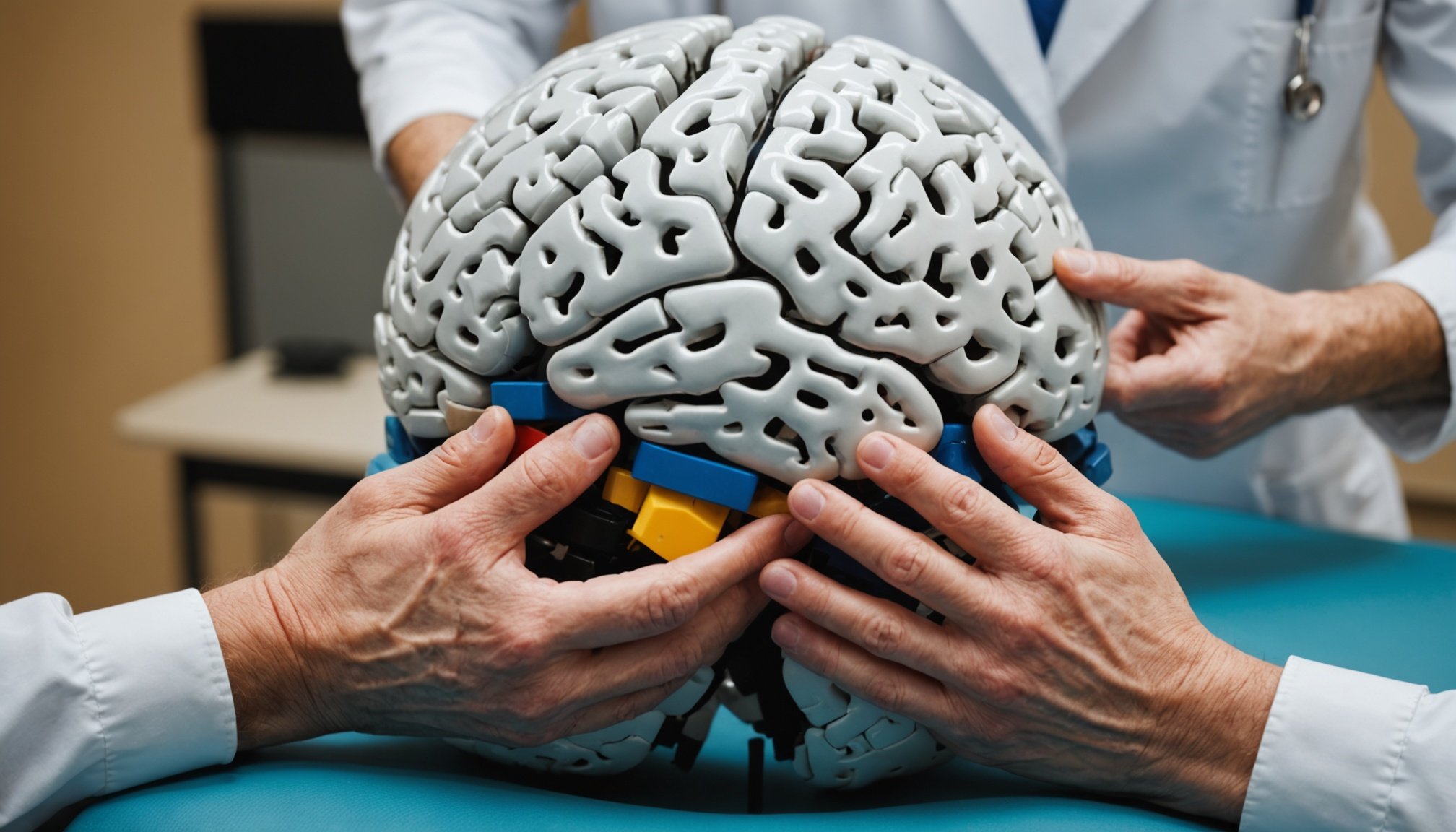Unlocking Recovery: The Role of Occupational Therapy in Healing Traumatic Brain Injuries
Traumatic brain injuries (TBIs) are complex and debilitating conditions that affect millions of people worldwide each year. These injuries can result from a variety of causes, including concussions, hematomas, and skull fractures, and they often necessitate comprehensive rehabilitation efforts to restore physical, cognitive, and psychological well-being. One of the key components of this rehabilitation process is occupational therapy, a specialized form of treatment that helps individuals regain the skills and abilities necessary for daily living.
Understanding Traumatic Brain Injuries
Before delving into the role of occupational therapy, it’s essential to understand the nature and impact of TBIs. These injuries can cause a wide range of symptoms, from immediate physical and cognitive impairments to long-term psychological and emotional challenges.
Also to read : Exploring the Impact of Smartphone Apps on Heart Rate Variability Tracking for Enhanced Anxiety Management
Physical Symptoms of TBI
Physical symptoms can include headache, dizziness, convulsions, blurred or double vision, and muscle weakness. These symptoms can make basic activities like walking, picking up objects, or even typing extremely challenging[5].
Cognitive and Behavioral Symptoms of TBI
Cognitive deficits are common, affecting memory, attention, executive function, and information processing. For instance, moderate to severe TBIs can lead to attention deficits in 56% of individuals and memory loss in 67% of individuals[2].
In the same genre : Enhancing Chronic Kidney Disease Management: The Impact of Nutritional Strategies on Patient Outcomes
Emotional and Psychological Impact
TBIs can also have a profound emotional and psychological impact, leading to frustration, irritability, and changes in sleep patterns. These symptoms can significantly affect an individual’s ability to engage in meaningful activities and maintain relationships[5].
The Role of Occupational Therapy in TBI Rehabilitation
Occupational therapy is a crucial part of the holistic approach to TBI rehabilitation. Here’s how it helps:
Addressing Physical Impairments
Occupational therapists work closely with physical therapists to create personalized treatment plans that focus on improving motor skills, balance, and overall physical function. This can include resistance exercises, cardiovascular conditioning, and progressive strength training to strengthen muscles and joints and enhance endurance[2].
Cognitive Rehabilitation
Cognitive rehabilitation is another key aspect of occupational therapy for TBI survivors. Therapists use various exercises to improve brain function, including:
- Long- and short-term memory drills: These help patients to recall and retain information.
- Problem-solving scenarios: These exercises enhance critical thinking and decision-making skills.
- Planning exercises: These help patients organize and manage their daily activities.
- Attention-building exercises: These improve focus and concentration[2].
Managing Sensory and Emotional Challenges
Occupational therapists also help patients manage sensory sensitivities and emotional challenges. For example, they may create schedules or calendars to help patients manage their time and reduce physical, cognitive, and psychological fatigue. They also work on decreasing sensitivity to sensory stimuli such as lights and sounds[1].
A Holistic Approach to Rehabilitation
A holistic approach to TBI rehabilitation integrates various care teams and modalities to ensure a well-rounded recovery. Here’s how different disciplines collaborate:
Multidisciplinary Care Teams
A holistic approach involves healthcare providers, rehabilitation specialists, occupational therapists, speech-language pathologists, and neuropsychologists working together. This collaboration ensures a seamless transition between phases of care and recovery, addressing the interconnected factors of TBI[2].
Alternative Approaches
In addition to traditional therapies, alternative approaches such as mindfulness, meditation, and physical activities like yoga or tai chi can be integrated into the treatment plan. These methods help in reducing stress and improving overall well-being[2].
Practical Insights and Actionable Advice
For individuals or families dealing with the aftermath of a TBI, here are some practical insights and actionable advice:
Seek Immediate Medical Attention
If you or someone you know has experienced a head injury, it is crucial to seek immediate medical attention if any severe symptoms are observed, especially within the first 24 hours[5].
Do Not Wait to Seek Treatment
If symptoms persist after a concussion, do not wait to seek treatment. Early intervention can significantly improve recovery outcomes[4].
Create a Supportive Environment
Creating a supportive environment at home can greatly aid in the recovery process. This includes minimizing sensory stimuli, establishing a routine, and providing emotional support[1].
Success Stories and Testimonials
Real-life examples and testimonials from TBI survivors and their families highlight the effectiveness of occupational therapy in the recovery process.
A Survivor’s Story
“Occupational therapy was a game-changer for me. After my TBI, I struggled with simple tasks like cooking and managing my finances. My therapist helped me develop strategies to overcome these challenges, and now I’m able to live independently again.” – Sarah, TBI Survivor
The Science Behind Occupational Therapy
Occupational therapy leverages the concept of neuroplasticity—the brain’s ability to adapt and change in response to injury or experience. Here’s a deeper look:
Neuroplasticity and Brain Recovery
Neuroplasticity allows the brain to reorganize itself by forming new neural connections. Occupational therapy exploits this ability by providing targeted exercises and activities that stimulate brain recovery[5].
Evidence-Based Practices
Studies and research published on platforms like Google Scholar and PubMed support the efficacy of occupational therapy in TBI rehabilitation. These studies highlight the positive outcomes in cognitive, physical, and emotional recovery when occupational therapy is integrated into the treatment plan[5].
Table: Comparing Different Rehabilitation Approaches
| Rehabilitation Approach | Focus | Therapists Involved | Activities | Goals |
|---|---|---|---|---|
| Occupational Therapy | Daily living skills, cognitive function, sensory integration | Occupational therapists | Memory drills, problem-solving, planning exercises | Improve daily functioning, cognitive skills, and sensory tolerance |
| Physical Therapy | Physical function, motor skills, balance | Physical therapists | Resistance exercises, cardiovascular conditioning, strength training | Enhance physical endurance, strength, and mobility |
| Speech Therapy | Communication skills, language processing | Speech-language pathologists | Language exercises, communication strategies | Improve speech, language, and communication abilities |
| Cognitive Rehabilitation | Cognitive function, memory, attention | Neuropsychologists, occupational therapists | Attention-building exercises, memory drills, problem-solving scenarios | Restore cognitive functions, improve memory and attention |
| Holistic Approach | Overall well-being, emotional health | Multidisciplinary care teams | Mindfulness, meditation, physical activities like yoga or tai chi | Reduce stress, improve emotional well-being, and enhance overall recovery |
Traumatic brain injuries present significant challenges, but with the right approach, recovery is possible. Occupational therapy plays a pivotal role in this process by addressing physical, cognitive, and emotional impairments. By understanding the complexities of TBI, leveraging a holistic approach to rehabilitation, and integrating occupational therapy, individuals can unlock their path to recovery and regain the skills necessary for a fulfilling life.
In the words of a scholar in the field, “Occupational therapy is not just about helping patients perform tasks; it’s about enabling them to live meaningful lives despite their injuries.” This perspective underscores the importance of occupational therapy in the journey towards healing and recovery from traumatic brain injuries.











